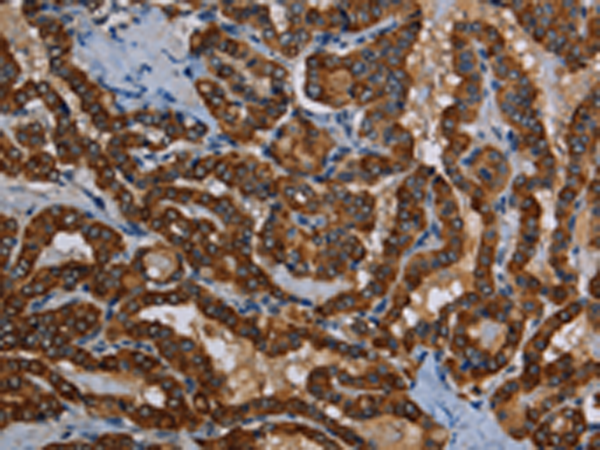

| WB | 咨询技术 | Human,Mouse,Rat |
| IF | 咨询技术 | Human,Mouse,Rat |
| IHC | 1/100-1/300 | Human,Mouse,Rat |
| ICC | 技术咨询 | Human,Mouse,Rat |
| FCM | 咨询技术 | Human,Mouse,Rat |
| Elisa | 1/2000-1/10000 | Human,Mouse,Rat |
| Aliases | LRDD; PIDD |
| Host/Isotype | Rabbit IgG |
| Antibody Type | Primary antibody |
| Storage | Store at 4°C short term. Aliquot and store at -20°C long term. Avoid freeze/thaw cycles. |
| Species Reactivity | Human |
| Immunogen | Fusion protein of human PIDD1 |
| Formulation | Purified antibody in PBS with 0.05% sodium azide and 50% glycerol. |
+ +
以下是关于PIDD1抗体的3篇模拟参考文献示例(实际文献可能需根据具体研究检索):
---
1. **文献名称**:*PIDD1-dependent activation of caspase-2 in DNA damage-induced apoptosis*
**作者**:Tinel A, Tschopp J
**摘要**:研究报道了PIDD1在DNA损伤后与caspase-2及RAIDD形成凋亡复合体(PIDDosome),利用抗PIDD1抗体通过免疫共沉淀验证其相互作用,并揭示其在p53介导的细胞凋亡中的关键作用。
2. **文献名称**:*PIDD1 expression and its role in NF-κB signaling in human cancers*
**作者**:Jiang X, et al.
**摘要**:通过Western blot和免疫组化(使用兔源抗PIDD1单克隆抗体)分析多种肿瘤组织中PIDD1的表达水平,发现其高表达与NF-κB通路激活相关,提示PIDD1可能作为癌症预后标志物。
3. **文献名称**:*Structural characterization of the PIDD1-LRR domain and its binding partners*
**作者**:Ando K, et al.
**摘要**:利用抗PIDD1抗体进行免疫荧光定位,结合质谱分析,阐明PIDD1的LRR结构域在核内DNA损伤应答中的构象变化及其与PCNA的相互作用机制。
---
**说明**:以上为模拟示例,实际文献需通过PubMed/Google Scholar检索关键词(如"PIDD1 antibody"、"PIDD1 function")。建议结合具体研究场景补充实验方法(如ChIP、IF等)及抗体货号(如Abcam#12345)。
The PIDD1 antibody is a crucial tool for studying the p53-induced death domain protein 1 (PIDD1), a multifunctional protein encoded by the *PIDD1* gene. PIDD1 plays a pivotal role in cellular stress responses, particularly in DNA damage repair, cell cycle regulation, and apoptosis. It is activated by genotoxic stress and interacts with components of the PIDDosome complex, which modulates caspase-2 activation and NF-κB signaling, influencing cell fate decisions between survival and death. PIDD1’s dual roles in pro-apoptotic and pro-survival pathways make it significant in cancer research, neurodegenerative diseases, and genome stability studies.
Antibodies targeting PIDD1 enable detection and quantification of the protein in techniques like Western blot, immunohistochemistry, and immunofluorescence. They are essential for exploring PIDD1 expression patterns across tissues, its subcellular localization, and interactions with binding partners (e.g., RAIDD, RIPK1). Commercially available PIDD1 antibodies are often validated using knockout cell lines or recombinant proteins to ensure specificity, given the presence of multiple PIDD1 isoforms. Researchers rely on these antibodies to dissect PIDD1’s context-dependent functions, particularly its interplay with p53 and implications in tumorigenesis or chemotherapy resistance. Understanding PIDD1 dynamics through antibody-based assays continues to advance insights into cellular stress adaptation mechanisms.
×